NSG2NCI Chronic Illness: Assessing Risks & Care for Patient Liz
VerifiedAdded on 2023/06/10
|9
|2532
|267
Essay
AI Summary
This essay presents a case study of a 49-year-old patient, Liz, who has been diagnosed with chronic bronchitis and is at risk of developing right ventricular failure leading to heart failure. The essay identifies the health services available in Australia that would aid Liz in managing her risk, including smoking cessation programs and services to address obesity and high cholesterol. It reflects on the potential benefits and challenges of these services, such as the public-private mix in healthcare funding, health inequalities, and issues within the medical research sector. The analysis emphasizes the importance of addressing risk factors like smoking, obesity, and high cholesterol to prevent further health complications for Liz, and highlights the barriers she might face in accessing necessary healthcare services.
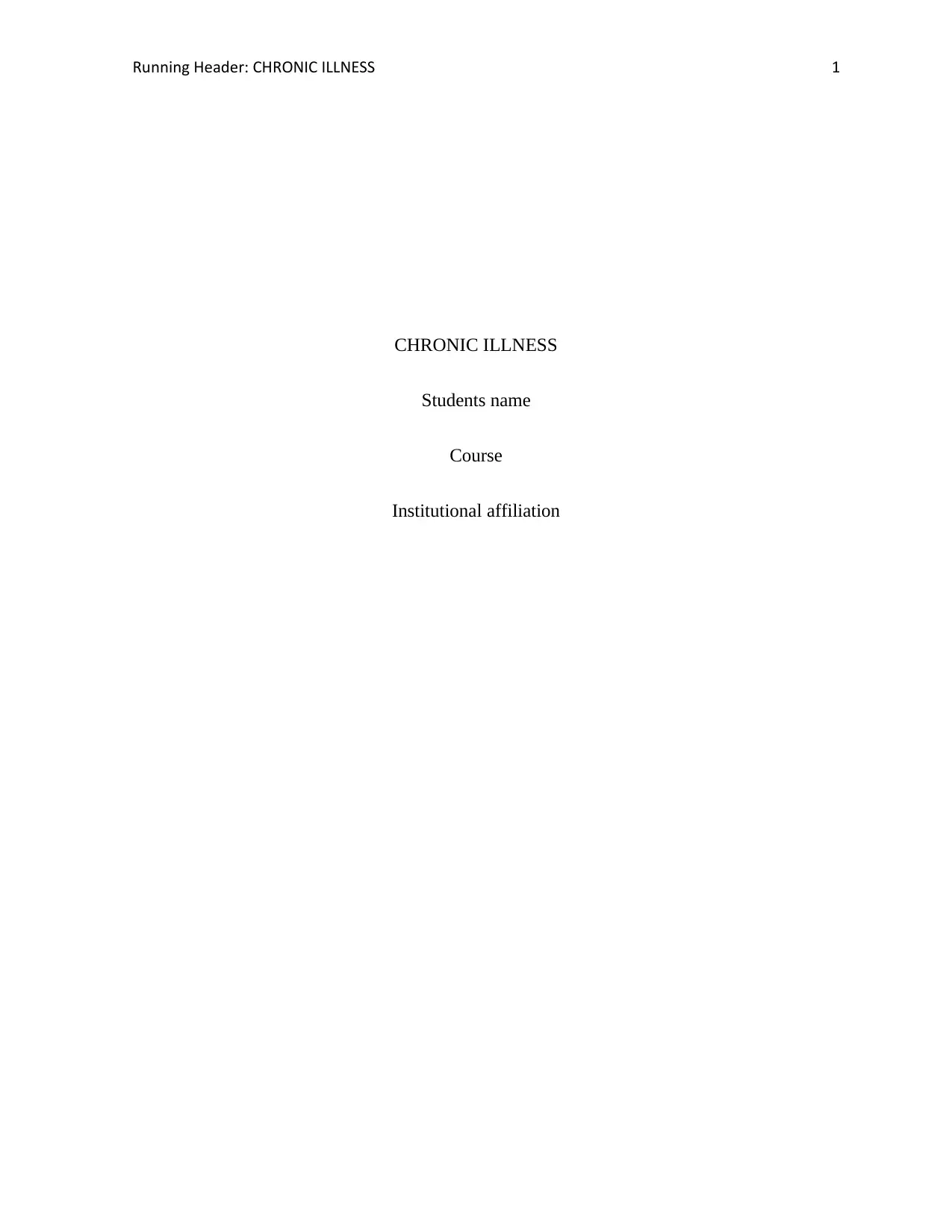
Running Header: CHRONIC ILLNESS 1
CHRONIC ILLNESS
Students name
Course
Institutional affiliation
CHRONIC ILLNESS
Students name
Course
Institutional affiliation
Paraphrase This Document
Need a fresh take? Get an instant paraphrase of this document with our AI Paraphraser
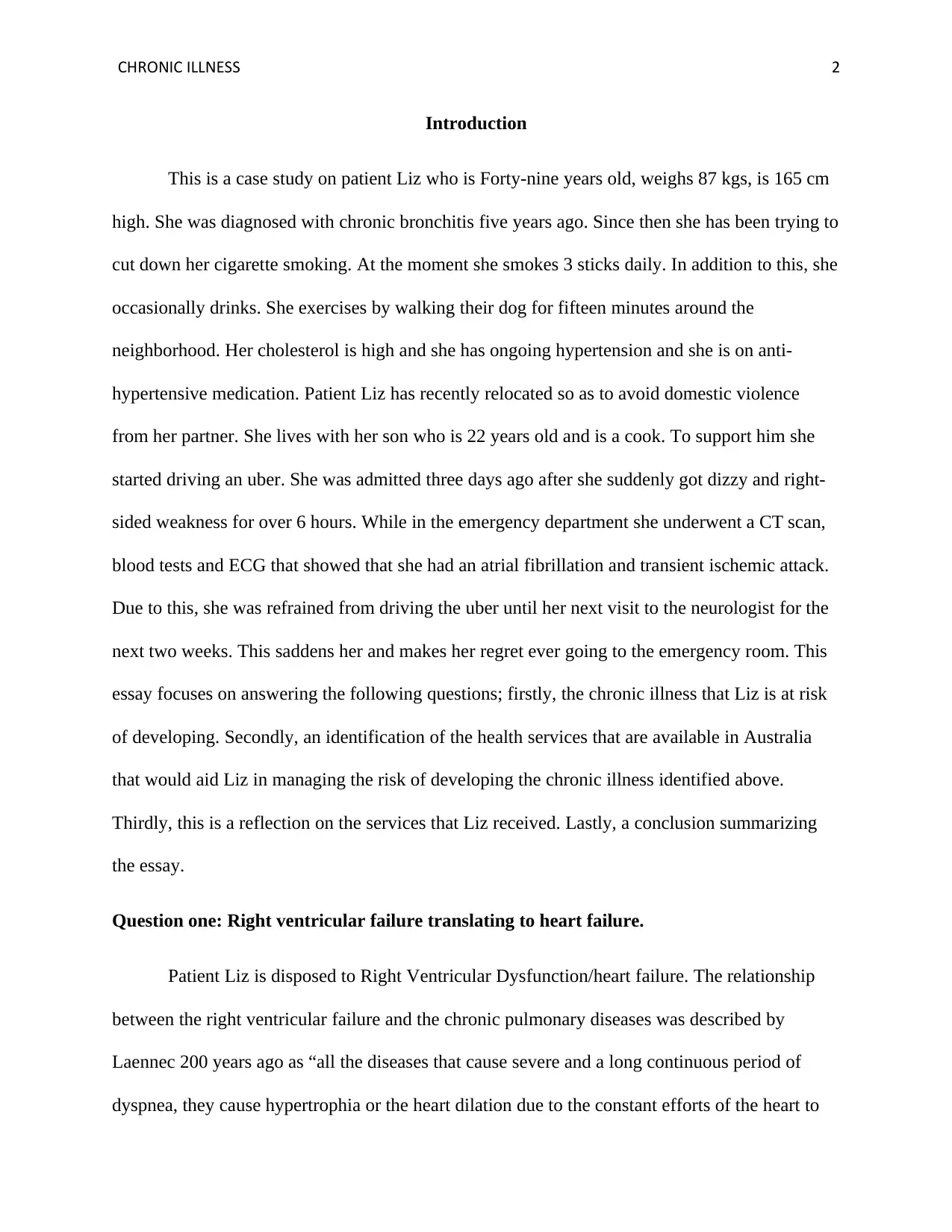
CHRONIC ILLNESS 2
Introduction
This is a case study on patient Liz who is Forty-nine years old, weighs 87 kgs, is 165 cm
high. She was diagnosed with chronic bronchitis five years ago. Since then she has been trying to
cut down her cigarette smoking. At the moment she smokes 3 sticks daily. In addition to this, she
occasionally drinks. She exercises by walking their dog for fifteen minutes around the
neighborhood. Her cholesterol is high and she has ongoing hypertension and she is on anti-
hypertensive medication. Patient Liz has recently relocated so as to avoid domestic violence
from her partner. She lives with her son who is 22 years old and is a cook. To support him she
started driving an uber. She was admitted three days ago after she suddenly got dizzy and right-
sided weakness for over 6 hours. While in the emergency department she underwent a CT scan,
blood tests and ECG that showed that she had an atrial fibrillation and transient ischemic attack.
Due to this, she was refrained from driving the uber until her next visit to the neurologist for the
next two weeks. This saddens her and makes her regret ever going to the emergency room. This
essay focuses on answering the following questions; firstly, the chronic illness that Liz is at risk
of developing. Secondly, an identification of the health services that are available in Australia
that would aid Liz in managing the risk of developing the chronic illness identified above.
Thirdly, this is a reflection on the services that Liz received. Lastly, a conclusion summarizing
the essay.
Question one: Right ventricular failure translating to heart failure.
Patient Liz is disposed to Right Ventricular Dysfunction/heart failure. The relationship
between the right ventricular failure and the chronic pulmonary diseases was described by
Laennec 200 years ago as “all the diseases that cause severe and a long continuous period of
dyspnea, they cause hypertrophia or the heart dilation due to the constant efforts of the heart to
Introduction
This is a case study on patient Liz who is Forty-nine years old, weighs 87 kgs, is 165 cm
high. She was diagnosed with chronic bronchitis five years ago. Since then she has been trying to
cut down her cigarette smoking. At the moment she smokes 3 sticks daily. In addition to this, she
occasionally drinks. She exercises by walking their dog for fifteen minutes around the
neighborhood. Her cholesterol is high and she has ongoing hypertension and she is on anti-
hypertensive medication. Patient Liz has recently relocated so as to avoid domestic violence
from her partner. She lives with her son who is 22 years old and is a cook. To support him she
started driving an uber. She was admitted three days ago after she suddenly got dizzy and right-
sided weakness for over 6 hours. While in the emergency department she underwent a CT scan,
blood tests and ECG that showed that she had an atrial fibrillation and transient ischemic attack.
Due to this, she was refrained from driving the uber until her next visit to the neurologist for the
next two weeks. This saddens her and makes her regret ever going to the emergency room. This
essay focuses on answering the following questions; firstly, the chronic illness that Liz is at risk
of developing. Secondly, an identification of the health services that are available in Australia
that would aid Liz in managing the risk of developing the chronic illness identified above.
Thirdly, this is a reflection on the services that Liz received. Lastly, a conclusion summarizing
the essay.
Question one: Right ventricular failure translating to heart failure.
Patient Liz is disposed to Right Ventricular Dysfunction/heart failure. The relationship
between the right ventricular failure and the chronic pulmonary diseases was described by
Laennec 200 years ago as “all the diseases that cause severe and a long continuous period of
dyspnea, they cause hypertrophia or the heart dilation due to the constant efforts of the heart to
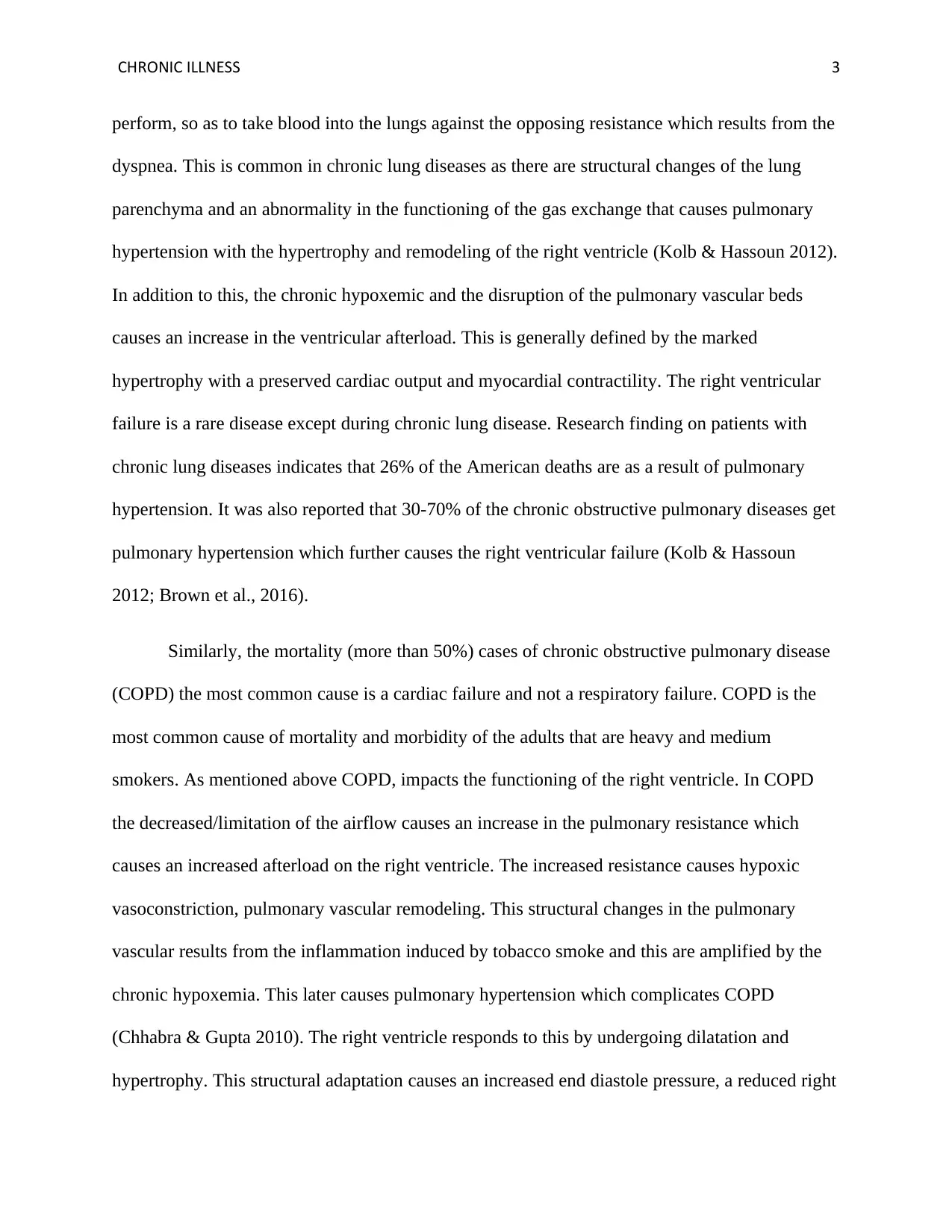
CHRONIC ILLNESS 3
perform, so as to take blood into the lungs against the opposing resistance which results from the
dyspnea. This is common in chronic lung diseases as there are structural changes of the lung
parenchyma and an abnormality in the functioning of the gas exchange that causes pulmonary
hypertension with the hypertrophy and remodeling of the right ventricle (Kolb & Hassoun 2012).
In addition to this, the chronic hypoxemic and the disruption of the pulmonary vascular beds
causes an increase in the ventricular afterload. This is generally defined by the marked
hypertrophy with a preserved cardiac output and myocardial contractility. The right ventricular
failure is a rare disease except during chronic lung disease. Research finding on patients with
chronic lung diseases indicates that 26% of the American deaths are as a result of pulmonary
hypertension. It was also reported that 30-70% of the chronic obstructive pulmonary diseases get
pulmonary hypertension which further causes the right ventricular failure (Kolb & Hassoun
2012; Brown et al., 2016).
Similarly, the mortality (more than 50%) cases of chronic obstructive pulmonary disease
(COPD) the most common cause is a cardiac failure and not a respiratory failure. COPD is the
most common cause of mortality and morbidity of the adults that are heavy and medium
smokers. As mentioned above COPD, impacts the functioning of the right ventricle. In COPD
the decreased/limitation of the airflow causes an increase in the pulmonary resistance which
causes an increased afterload on the right ventricle. The increased resistance causes hypoxic
vasoconstriction, pulmonary vascular remodeling. This structural changes in the pulmonary
vascular results from the inflammation induced by tobacco smoke and this are amplified by the
chronic hypoxemia. This later causes pulmonary hypertension which complicates COPD
(Chhabra & Gupta 2010). The right ventricle responds to this by undergoing dilatation and
hypertrophy. This structural adaptation causes an increased end diastole pressure, a reduced right
perform, so as to take blood into the lungs against the opposing resistance which results from the
dyspnea. This is common in chronic lung diseases as there are structural changes of the lung
parenchyma and an abnormality in the functioning of the gas exchange that causes pulmonary
hypertension with the hypertrophy and remodeling of the right ventricle (Kolb & Hassoun 2012).
In addition to this, the chronic hypoxemic and the disruption of the pulmonary vascular beds
causes an increase in the ventricular afterload. This is generally defined by the marked
hypertrophy with a preserved cardiac output and myocardial contractility. The right ventricular
failure is a rare disease except during chronic lung disease. Research finding on patients with
chronic lung diseases indicates that 26% of the American deaths are as a result of pulmonary
hypertension. It was also reported that 30-70% of the chronic obstructive pulmonary diseases get
pulmonary hypertension which further causes the right ventricular failure (Kolb & Hassoun
2012; Brown et al., 2016).
Similarly, the mortality (more than 50%) cases of chronic obstructive pulmonary disease
(COPD) the most common cause is a cardiac failure and not a respiratory failure. COPD is the
most common cause of mortality and morbidity of the adults that are heavy and medium
smokers. As mentioned above COPD, impacts the functioning of the right ventricle. In COPD
the decreased/limitation of the airflow causes an increase in the pulmonary resistance which
causes an increased afterload on the right ventricle. The increased resistance causes hypoxic
vasoconstriction, pulmonary vascular remodeling. This structural changes in the pulmonary
vascular results from the inflammation induced by tobacco smoke and this are amplified by the
chronic hypoxemia. This later causes pulmonary hypertension which complicates COPD
(Chhabra & Gupta 2010). The right ventricle responds to this by undergoing dilatation and
hypertrophy. This structural adaptation causes an increased end diastole pressure, a reduced right
⊘ This is a preview!⊘
Do you want full access?
Subscribe today to unlock all pages.

Trusted by 1+ million students worldwide
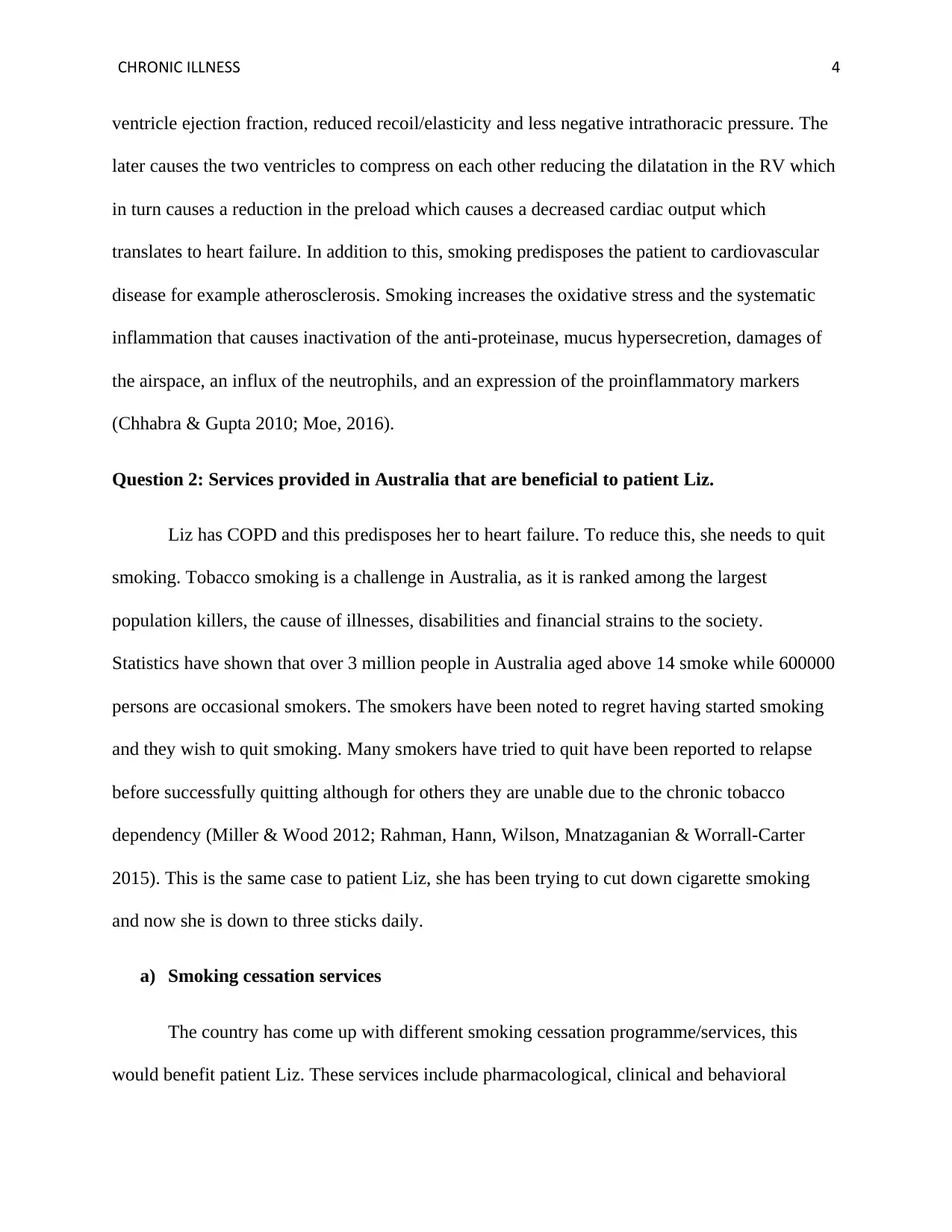
CHRONIC ILLNESS 4
ventricle ejection fraction, reduced recoil/elasticity and less negative intrathoracic pressure. The
later causes the two ventricles to compress on each other reducing the dilatation in the RV which
in turn causes a reduction in the preload which causes a decreased cardiac output which
translates to heart failure. In addition to this, smoking predisposes the patient to cardiovascular
disease for example atherosclerosis. Smoking increases the oxidative stress and the systematic
inflammation that causes inactivation of the anti-proteinase, mucus hypersecretion, damages of
the airspace, an influx of the neutrophils, and an expression of the proinflammatory markers
(Chhabra & Gupta 2010; Moe, 2016).
Question 2: Services provided in Australia that are beneficial to patient Liz.
Liz has COPD and this predisposes her to heart failure. To reduce this, she needs to quit
smoking. Tobacco smoking is a challenge in Australia, as it is ranked among the largest
population killers, the cause of illnesses, disabilities and financial strains to the society.
Statistics have shown that over 3 million people in Australia aged above 14 smoke while 600000
persons are occasional smokers. The smokers have been noted to regret having started smoking
and they wish to quit smoking. Many smokers have tried to quit have been reported to relapse
before successfully quitting although for others they are unable due to the chronic tobacco
dependency (Miller & Wood 2012; Rahman, Hann, Wilson, Mnatzaganian & Worrall-Carter
2015). This is the same case to patient Liz, she has been trying to cut down cigarette smoking
and now she is down to three sticks daily.
a) Smoking cessation services
The country has come up with different smoking cessation programme/services, this
would benefit patient Liz. These services include pharmacological, clinical and behavioral
ventricle ejection fraction, reduced recoil/elasticity and less negative intrathoracic pressure. The
later causes the two ventricles to compress on each other reducing the dilatation in the RV which
in turn causes a reduction in the preload which causes a decreased cardiac output which
translates to heart failure. In addition to this, smoking predisposes the patient to cardiovascular
disease for example atherosclerosis. Smoking increases the oxidative stress and the systematic
inflammation that causes inactivation of the anti-proteinase, mucus hypersecretion, damages of
the airspace, an influx of the neutrophils, and an expression of the proinflammatory markers
(Chhabra & Gupta 2010; Moe, 2016).
Question 2: Services provided in Australia that are beneficial to patient Liz.
Liz has COPD and this predisposes her to heart failure. To reduce this, she needs to quit
smoking. Tobacco smoking is a challenge in Australia, as it is ranked among the largest
population killers, the cause of illnesses, disabilities and financial strains to the society.
Statistics have shown that over 3 million people in Australia aged above 14 smoke while 600000
persons are occasional smokers. The smokers have been noted to regret having started smoking
and they wish to quit smoking. Many smokers have tried to quit have been reported to relapse
before successfully quitting although for others they are unable due to the chronic tobacco
dependency (Miller & Wood 2012; Rahman, Hann, Wilson, Mnatzaganian & Worrall-Carter
2015). This is the same case to patient Liz, she has been trying to cut down cigarette smoking
and now she is down to three sticks daily.
a) Smoking cessation services
The country has come up with different smoking cessation programme/services, this
would benefit patient Liz. These services include pharmacological, clinical and behavioral
Paraphrase This Document
Need a fresh take? Get an instant paraphrase of this document with our AI Paraphraser
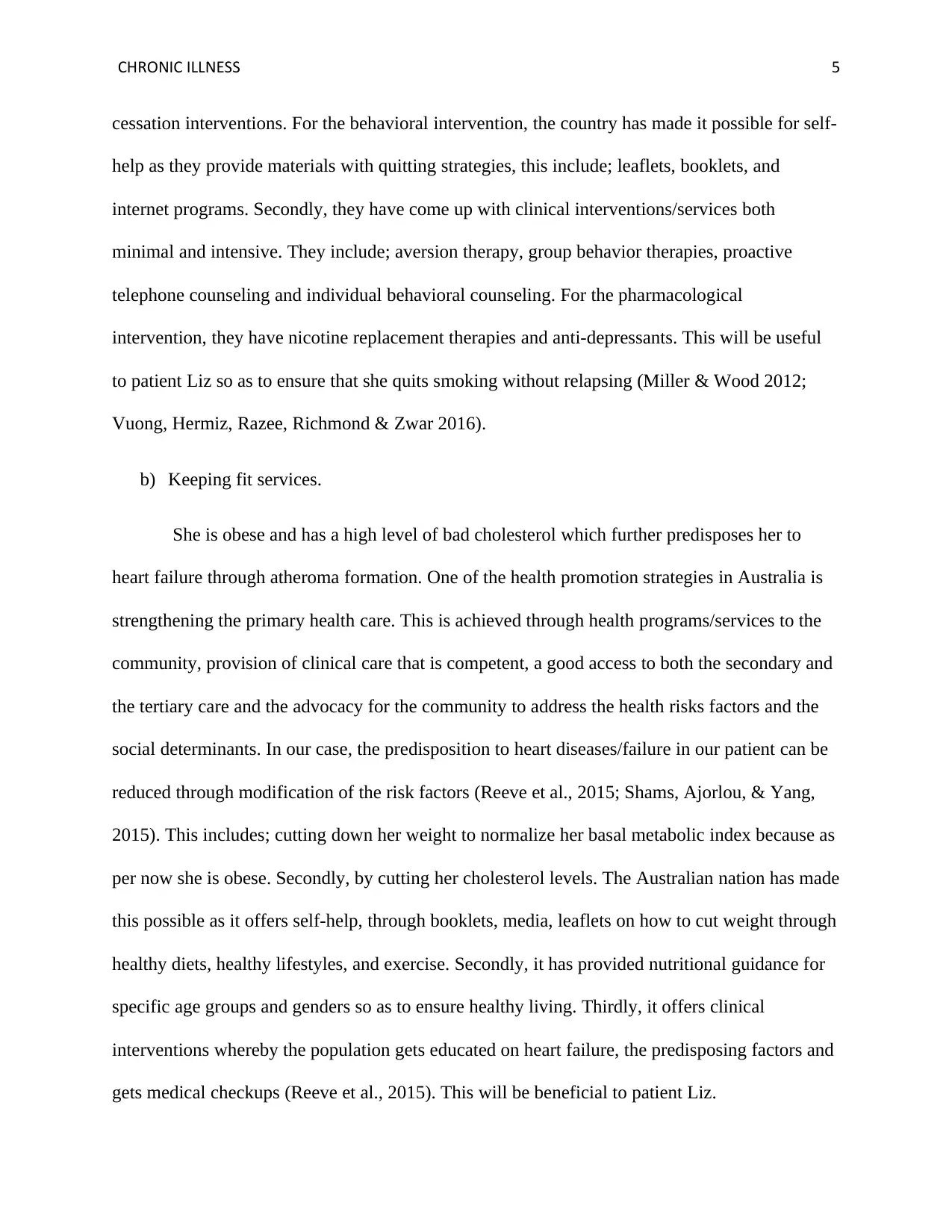
CHRONIC ILLNESS 5
cessation interventions. For the behavioral intervention, the country has made it possible for self-
help as they provide materials with quitting strategies, this include; leaflets, booklets, and
internet programs. Secondly, they have come up with clinical interventions/services both
minimal and intensive. They include; aversion therapy, group behavior therapies, proactive
telephone counseling and individual behavioral counseling. For the pharmacological
intervention, they have nicotine replacement therapies and anti-depressants. This will be useful
to patient Liz so as to ensure that she quits smoking without relapsing (Miller & Wood 2012;
Vuong, Hermiz, Razee, Richmond & Zwar 2016).
b) Keeping fit services.
She is obese and has a high level of bad cholesterol which further predisposes her to
heart failure through atheroma formation. One of the health promotion strategies in Australia is
strengthening the primary health care. This is achieved through health programs/services to the
community, provision of clinical care that is competent, a good access to both the secondary and
the tertiary care and the advocacy for the community to address the health risks factors and the
social determinants. In our case, the predisposition to heart diseases/failure in our patient can be
reduced through modification of the risk factors (Reeve et al., 2015; Shams, Ajorlou, & Yang,
2015). This includes; cutting down her weight to normalize her basal metabolic index because as
per now she is obese. Secondly, by cutting her cholesterol levels. The Australian nation has made
this possible as it offers self-help, through booklets, media, leaflets on how to cut weight through
healthy diets, healthy lifestyles, and exercise. Secondly, it has provided nutritional guidance for
specific age groups and genders so as to ensure healthy living. Thirdly, it offers clinical
interventions whereby the population gets educated on heart failure, the predisposing factors and
gets medical checkups (Reeve et al., 2015). This will be beneficial to patient Liz.
cessation interventions. For the behavioral intervention, the country has made it possible for self-
help as they provide materials with quitting strategies, this include; leaflets, booklets, and
internet programs. Secondly, they have come up with clinical interventions/services both
minimal and intensive. They include; aversion therapy, group behavior therapies, proactive
telephone counseling and individual behavioral counseling. For the pharmacological
intervention, they have nicotine replacement therapies and anti-depressants. This will be useful
to patient Liz so as to ensure that she quits smoking without relapsing (Miller & Wood 2012;
Vuong, Hermiz, Razee, Richmond & Zwar 2016).
b) Keeping fit services.
She is obese and has a high level of bad cholesterol which further predisposes her to
heart failure through atheroma formation. One of the health promotion strategies in Australia is
strengthening the primary health care. This is achieved through health programs/services to the
community, provision of clinical care that is competent, a good access to both the secondary and
the tertiary care and the advocacy for the community to address the health risks factors and the
social determinants. In our case, the predisposition to heart diseases/failure in our patient can be
reduced through modification of the risk factors (Reeve et al., 2015; Shams, Ajorlou, & Yang,
2015). This includes; cutting down her weight to normalize her basal metabolic index because as
per now she is obese. Secondly, by cutting her cholesterol levels. The Australian nation has made
this possible as it offers self-help, through booklets, media, leaflets on how to cut weight through
healthy diets, healthy lifestyles, and exercise. Secondly, it has provided nutritional guidance for
specific age groups and genders so as to ensure healthy living. Thirdly, it offers clinical
interventions whereby the population gets educated on heart failure, the predisposing factors and
gets medical checkups (Reeve et al., 2015). This will be beneficial to patient Liz.
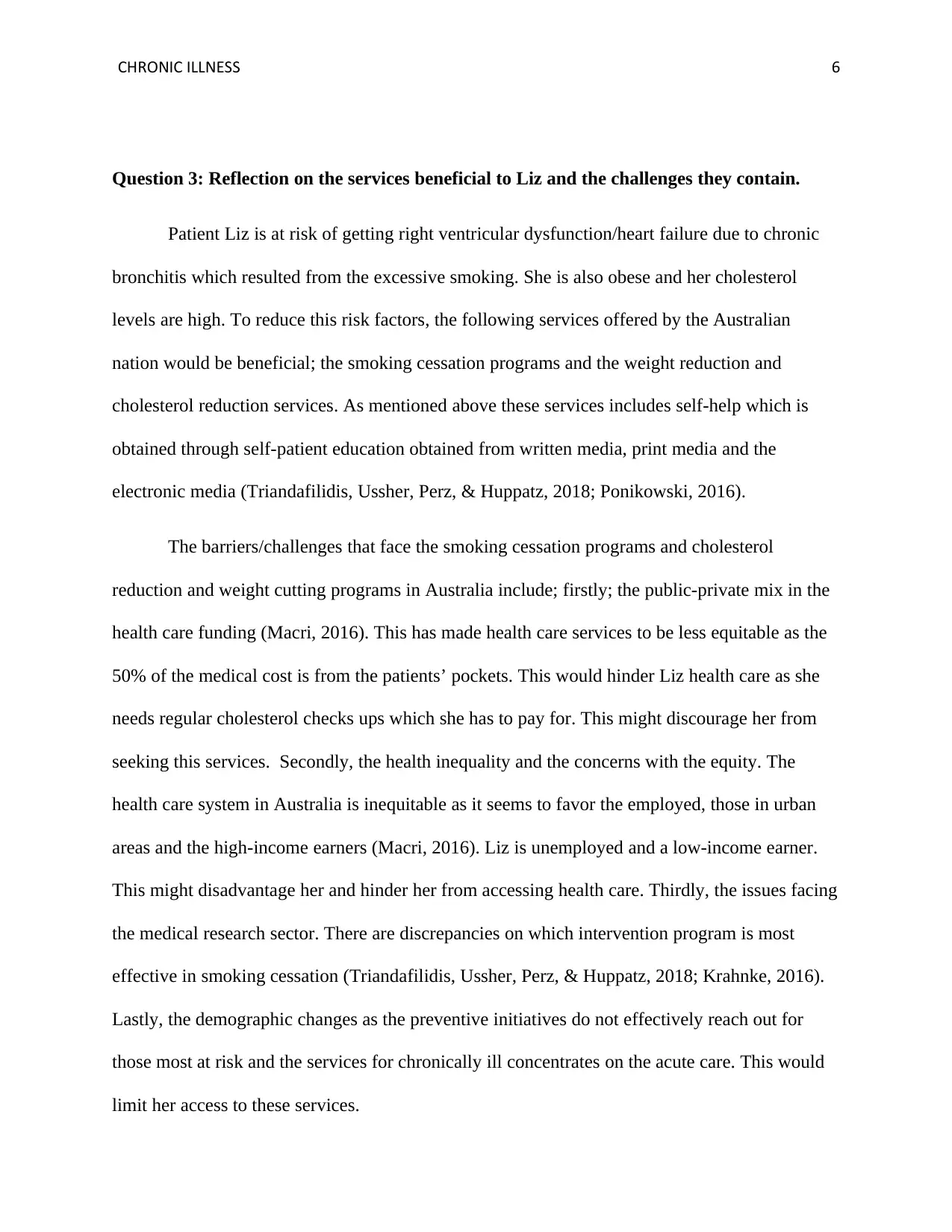
CHRONIC ILLNESS 6
Question 3: Reflection on the services beneficial to Liz and the challenges they contain.
Patient Liz is at risk of getting right ventricular dysfunction/heart failure due to chronic
bronchitis which resulted from the excessive smoking. She is also obese and her cholesterol
levels are high. To reduce this risk factors, the following services offered by the Australian
nation would be beneficial; the smoking cessation programs and the weight reduction and
cholesterol reduction services. As mentioned above these services includes self-help which is
obtained through self-patient education obtained from written media, print media and the
electronic media (Triandafilidis, Ussher, Perz, & Huppatz, 2018; Ponikowski, 2016).
The barriers/challenges that face the smoking cessation programs and cholesterol
reduction and weight cutting programs in Australia include; firstly; the public-private mix in the
health care funding (Macri, 2016). This has made health care services to be less equitable as the
50% of the medical cost is from the patients’ pockets. This would hinder Liz health care as she
needs regular cholesterol checks ups which she has to pay for. This might discourage her from
seeking this services. Secondly, the health inequality and the concerns with the equity. The
health care system in Australia is inequitable as it seems to favor the employed, those in urban
areas and the high-income earners (Macri, 2016). Liz is unemployed and a low-income earner.
This might disadvantage her and hinder her from accessing health care. Thirdly, the issues facing
the medical research sector. There are discrepancies on which intervention program is most
effective in smoking cessation (Triandafilidis, Ussher, Perz, & Huppatz, 2018; Krahnke, 2016).
Lastly, the demographic changes as the preventive initiatives do not effectively reach out for
those most at risk and the services for chronically ill concentrates on the acute care. This would
limit her access to these services.
Question 3: Reflection on the services beneficial to Liz and the challenges they contain.
Patient Liz is at risk of getting right ventricular dysfunction/heart failure due to chronic
bronchitis which resulted from the excessive smoking. She is also obese and her cholesterol
levels are high. To reduce this risk factors, the following services offered by the Australian
nation would be beneficial; the smoking cessation programs and the weight reduction and
cholesterol reduction services. As mentioned above these services includes self-help which is
obtained through self-patient education obtained from written media, print media and the
electronic media (Triandafilidis, Ussher, Perz, & Huppatz, 2018; Ponikowski, 2016).
The barriers/challenges that face the smoking cessation programs and cholesterol
reduction and weight cutting programs in Australia include; firstly; the public-private mix in the
health care funding (Macri, 2016). This has made health care services to be less equitable as the
50% of the medical cost is from the patients’ pockets. This would hinder Liz health care as she
needs regular cholesterol checks ups which she has to pay for. This might discourage her from
seeking this services. Secondly, the health inequality and the concerns with the equity. The
health care system in Australia is inequitable as it seems to favor the employed, those in urban
areas and the high-income earners (Macri, 2016). Liz is unemployed and a low-income earner.
This might disadvantage her and hinder her from accessing health care. Thirdly, the issues facing
the medical research sector. There are discrepancies on which intervention program is most
effective in smoking cessation (Triandafilidis, Ussher, Perz, & Huppatz, 2018; Krahnke, 2016).
Lastly, the demographic changes as the preventive initiatives do not effectively reach out for
those most at risk and the services for chronically ill concentrates on the acute care. This would
limit her access to these services.
⊘ This is a preview!⊘
Do you want full access?
Subscribe today to unlock all pages.

Trusted by 1+ million students worldwide
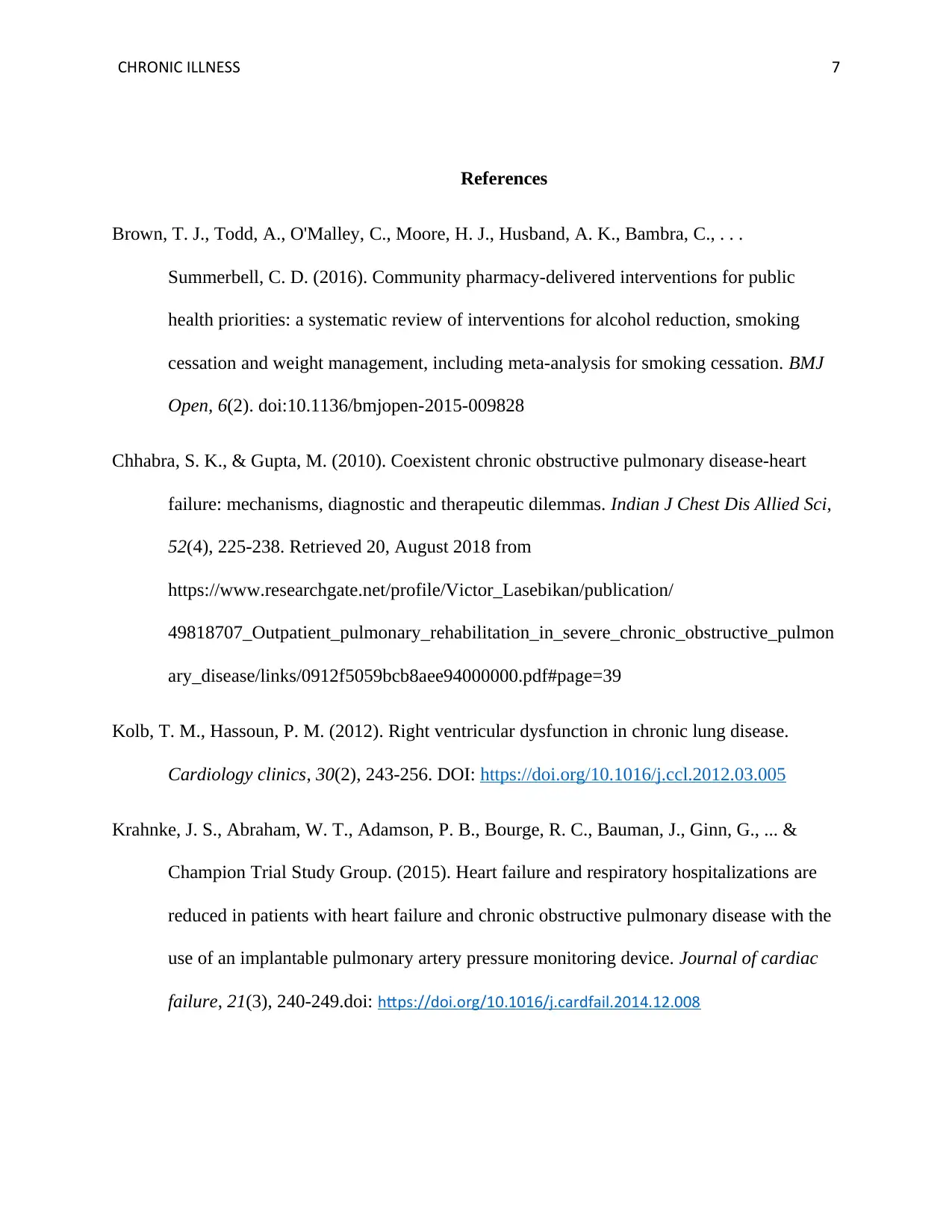
CHRONIC ILLNESS 7
References
Brown, T. J., Todd, A., O'Malley, C., Moore, H. J., Husband, A. K., Bambra, C., . . .
Summerbell, C. D. (2016). Community pharmacy-delivered interventions for public
health priorities: a systematic review of interventions for alcohol reduction, smoking
cessation and weight management, including meta-analysis for smoking cessation. BMJ
Open, 6(2). doi:10.1136/bmjopen-2015-009828
Chhabra, S. K., & Gupta, M. (2010). Coexistent chronic obstructive pulmonary disease-heart
failure: mechanisms, diagnostic and therapeutic dilemmas. Indian J Chest Dis Allied Sci,
52(4), 225-238. Retrieved 20, August 2018 from
https://www.researchgate.net/profile/Victor_Lasebikan/publication/
49818707_Outpatient_pulmonary_rehabilitation_in_severe_chronic_obstructive_pulmon
ary_disease/links/0912f5059bcb8aee94000000.pdf#page=39
Kolb, T. M., Hassoun, P. M. (2012). Right ventricular dysfunction in chronic lung disease.
Cardiology clinics, 30(2), 243-256. DOI: https://doi.org/10.1016/j.ccl.2012.03.005
Krahnke, J. S., Abraham, W. T., Adamson, P. B., Bourge, R. C., Bauman, J., Ginn, G., ... &
Champion Trial Study Group. (2015). Heart failure and respiratory hospitalizations are
reduced in patients with heart failure and chronic obstructive pulmonary disease with the
use of an implantable pulmonary artery pressure monitoring device. Journal of cardiac
failure, 21(3), 240-249.doi: https://doi.org/10.1016/j.cardfail.2014.12.008
References
Brown, T. J., Todd, A., O'Malley, C., Moore, H. J., Husband, A. K., Bambra, C., . . .
Summerbell, C. D. (2016). Community pharmacy-delivered interventions for public
health priorities: a systematic review of interventions for alcohol reduction, smoking
cessation and weight management, including meta-analysis for smoking cessation. BMJ
Open, 6(2). doi:10.1136/bmjopen-2015-009828
Chhabra, S. K., & Gupta, M. (2010). Coexistent chronic obstructive pulmonary disease-heart
failure: mechanisms, diagnostic and therapeutic dilemmas. Indian J Chest Dis Allied Sci,
52(4), 225-238. Retrieved 20, August 2018 from
https://www.researchgate.net/profile/Victor_Lasebikan/publication/
49818707_Outpatient_pulmonary_rehabilitation_in_severe_chronic_obstructive_pulmon
ary_disease/links/0912f5059bcb8aee94000000.pdf#page=39
Kolb, T. M., Hassoun, P. M. (2012). Right ventricular dysfunction in chronic lung disease.
Cardiology clinics, 30(2), 243-256. DOI: https://doi.org/10.1016/j.ccl.2012.03.005
Krahnke, J. S., Abraham, W. T., Adamson, P. B., Bourge, R. C., Bauman, J., Ginn, G., ... &
Champion Trial Study Group. (2015). Heart failure and respiratory hospitalizations are
reduced in patients with heart failure and chronic obstructive pulmonary disease with the
use of an implantable pulmonary artery pressure monitoring device. Journal of cardiac
failure, 21(3), 240-249.doi: https://doi.org/10.1016/j.cardfail.2014.12.008
Paraphrase This Document
Need a fresh take? Get an instant paraphrase of this document with our AI Paraphraser
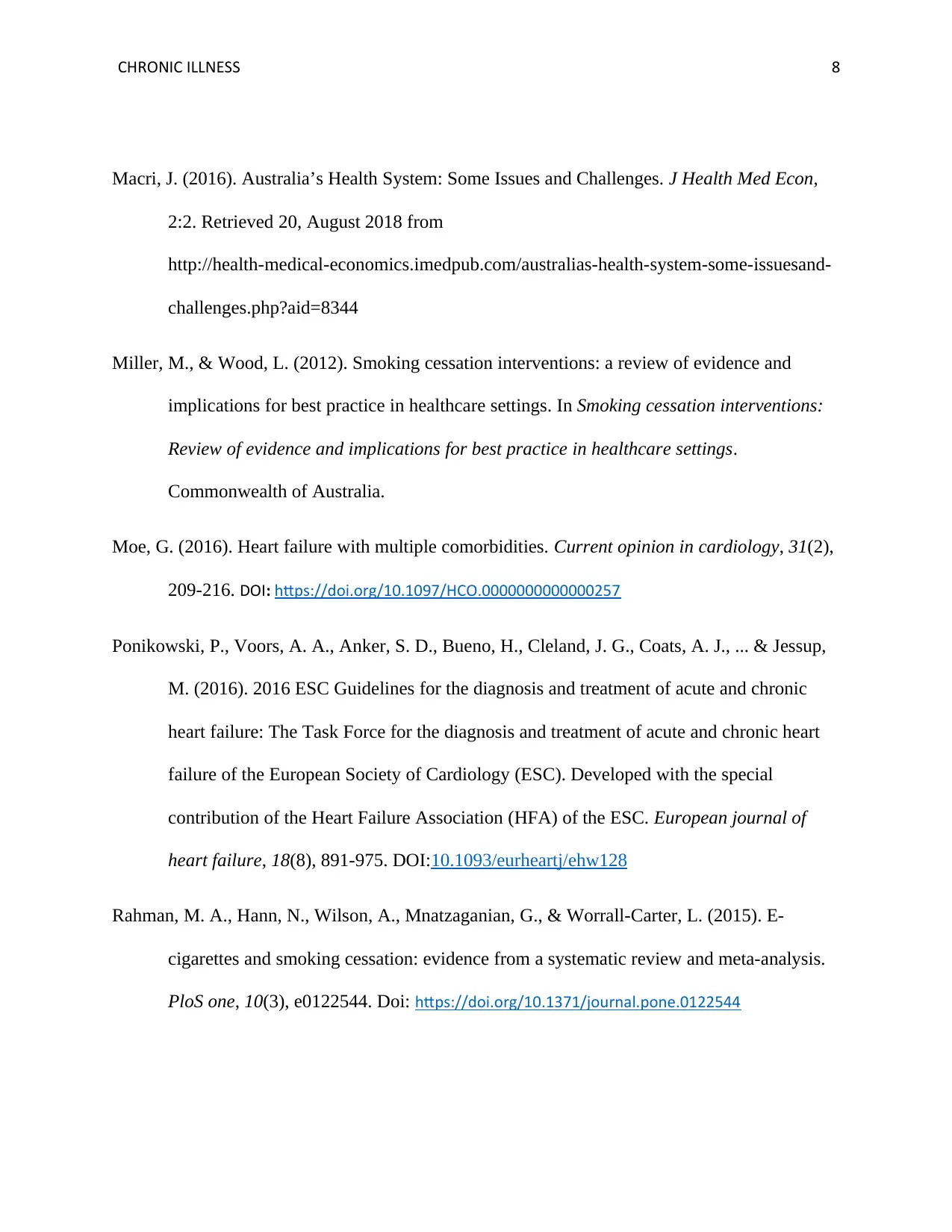
CHRONIC ILLNESS 8
Macri, J. (2016). Australia’s Health System: Some Issues and Challenges. J Health Med Econ,
2:2. Retrieved 20, August 2018 from
http://health-medical-economics.imedpub.com/australias-health-system-some-issuesand-
challenges.php?aid=8344
Miller, M., & Wood, L. (2012). Smoking cessation interventions: a review of evidence and
implications for best practice in healthcare settings. In Smoking cessation interventions:
Review of evidence and implications for best practice in healthcare settings.
Commonwealth of Australia.
Moe, G. (2016). Heart failure with multiple comorbidities. Current opinion in cardiology, 31(2),
209-216. DOI: https://doi.org/10.1097/HCO.0000000000000257
Ponikowski, P., Voors, A. A., Anker, S. D., Bueno, H., Cleland, J. G., Coats, A. J., ... & Jessup,
M. (2016). 2016 ESC Guidelines for the diagnosis and treatment of acute and chronic
heart failure: The Task Force for the diagnosis and treatment of acute and chronic heart
failure of the European Society of Cardiology (ESC). Developed with the special
contribution of the Heart Failure Association (HFA) of the ESC. European journal of
heart failure, 18(8), 891-975. DOI:10.1093/eurheartj/ehw128
Rahman, M. A., Hann, N., Wilson, A., Mnatzaganian, G., & Worrall-Carter, L. (2015). E-
cigarettes and smoking cessation: evidence from a systematic review and meta-analysis.
PloS one, 10(3), e0122544. Doi: https://doi.org/10.1371/journal.pone.0122544
Macri, J. (2016). Australia’s Health System: Some Issues and Challenges. J Health Med Econ,
2:2. Retrieved 20, August 2018 from
http://health-medical-economics.imedpub.com/australias-health-system-some-issuesand-
challenges.php?aid=8344
Miller, M., & Wood, L. (2012). Smoking cessation interventions: a review of evidence and
implications for best practice in healthcare settings. In Smoking cessation interventions:
Review of evidence and implications for best practice in healthcare settings.
Commonwealth of Australia.
Moe, G. (2016). Heart failure with multiple comorbidities. Current opinion in cardiology, 31(2),
209-216. DOI: https://doi.org/10.1097/HCO.0000000000000257
Ponikowski, P., Voors, A. A., Anker, S. D., Bueno, H., Cleland, J. G., Coats, A. J., ... & Jessup,
M. (2016). 2016 ESC Guidelines for the diagnosis and treatment of acute and chronic
heart failure: The Task Force for the diagnosis and treatment of acute and chronic heart
failure of the European Society of Cardiology (ESC). Developed with the special
contribution of the Heart Failure Association (HFA) of the ESC. European journal of
heart failure, 18(8), 891-975. DOI:10.1093/eurheartj/ehw128
Rahman, M. A., Hann, N., Wilson, A., Mnatzaganian, G., & Worrall-Carter, L. (2015). E-
cigarettes and smoking cessation: evidence from a systematic review and meta-analysis.
PloS one, 10(3), e0122544. Doi: https://doi.org/10.1371/journal.pone.0122544
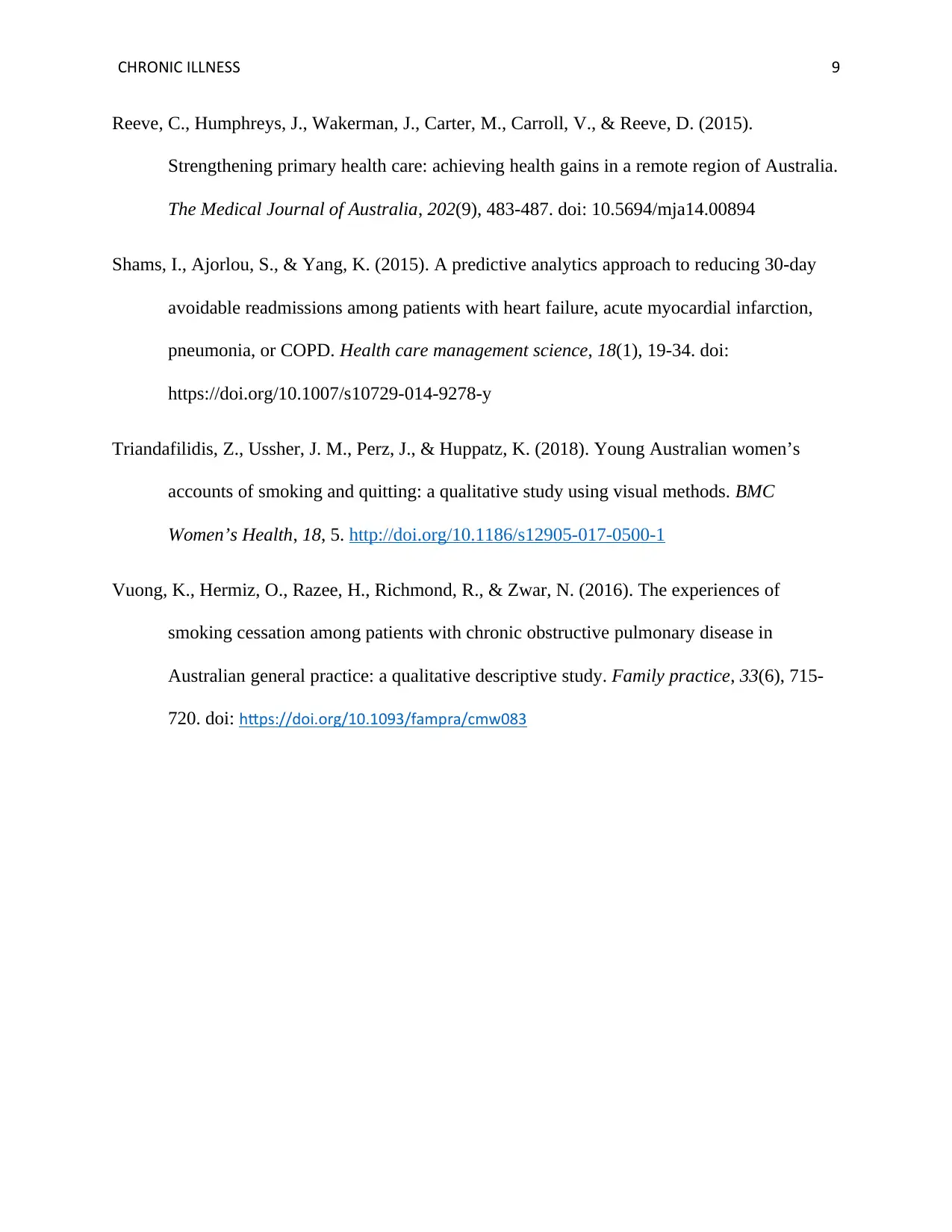
CHRONIC ILLNESS 9
Reeve, C., Humphreys, J., Wakerman, J., Carter, M., Carroll, V., & Reeve, D. (2015).
Strengthening primary health care: achieving health gains in a remote region of Australia.
The Medical Journal of Australia, 202(9), 483-487. doi: 10.5694/mja14.00894
Shams, I., Ajorlou, S., & Yang, K. (2015). A predictive analytics approach to reducing 30-day
avoidable readmissions among patients with heart failure, acute myocardial infarction,
pneumonia, or COPD. Health care management science, 18(1), 19-34. doi:
https://doi.org/10.1007/s10729-014-9278-y
Triandafilidis, Z., Ussher, J. M., Perz, J., & Huppatz, K. (2018). Young Australian women’s
accounts of smoking and quitting: a qualitative study using visual methods. BMC
Women’s Health, 18, 5. http://doi.org/10.1186/s12905-017-0500-1
Vuong, K., Hermiz, O., Razee, H., Richmond, R., & Zwar, N. (2016). The experiences of
smoking cessation among patients with chronic obstructive pulmonary disease in
Australian general practice: a qualitative descriptive study. Family practice, 33(6), 715-
720. doi: https://doi.org/10.1093/fampra/cmw083
Reeve, C., Humphreys, J., Wakerman, J., Carter, M., Carroll, V., & Reeve, D. (2015).
Strengthening primary health care: achieving health gains in a remote region of Australia.
The Medical Journal of Australia, 202(9), 483-487. doi: 10.5694/mja14.00894
Shams, I., Ajorlou, S., & Yang, K. (2015). A predictive analytics approach to reducing 30-day
avoidable readmissions among patients with heart failure, acute myocardial infarction,
pneumonia, or COPD. Health care management science, 18(1), 19-34. doi:
https://doi.org/10.1007/s10729-014-9278-y
Triandafilidis, Z., Ussher, J. M., Perz, J., & Huppatz, K. (2018). Young Australian women’s
accounts of smoking and quitting: a qualitative study using visual methods. BMC
Women’s Health, 18, 5. http://doi.org/10.1186/s12905-017-0500-1
Vuong, K., Hermiz, O., Razee, H., Richmond, R., & Zwar, N. (2016). The experiences of
smoking cessation among patients with chronic obstructive pulmonary disease in
Australian general practice: a qualitative descriptive study. Family practice, 33(6), 715-
720. doi: https://doi.org/10.1093/fampra/cmw083
⊘ This is a preview!⊘
Do you want full access?
Subscribe today to unlock all pages.

Trusted by 1+ million students worldwide
1 out of 9
Related Documents
Your All-in-One AI-Powered Toolkit for Academic Success.
+13062052269
info@desklib.com
Available 24*7 on WhatsApp / Email
![[object Object]](/_next/static/media/star-bottom.7253800d.svg)
Unlock your academic potential
Copyright © 2020–2025 A2Z Services. All Rights Reserved. Developed and managed by ZUCOL.





